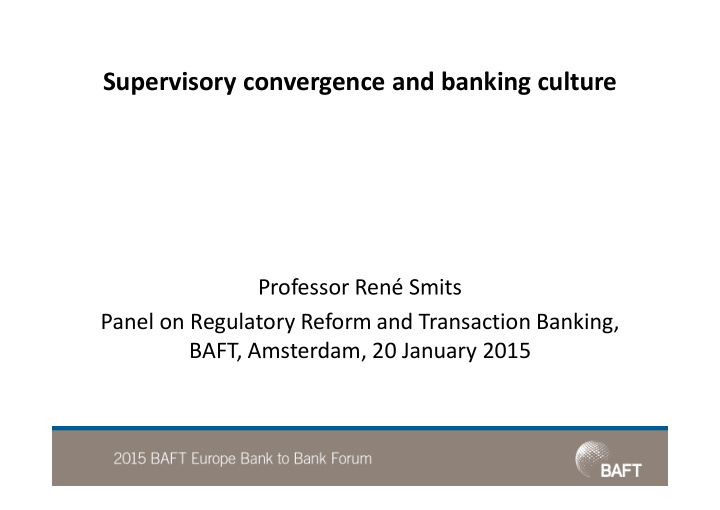



Supervisory convergence and banking culture Professor René Smits Panel on Regulatory Reform and Transaction Banking, BAFT, Amsterdam, 20 January 2015
Disclosure & disclaimer � Professor, Law of the Economic and Monetary Union, University of Amsterdam � Alternate Member, Administrative Board of Review (ABoR), European Central Bank � Assessor, Competition College, Belgian Competition Authority (BCA) � Consultant, EMU law and EU banking regulation, RS Law & Society Consulting B.V. � Strict confidentiality in respect of ABoR & BCA functions
Supervisory practices: towards a European supervisory culture � Reminder: ‘ what is banking union ’ ? � SSM= ECB + NCAs � Recovery & resolution: second ‘ leg ’ of banking union � Third ‘ leg ’ : deposit insurance � Based on ‘ single rulebook ’ (CRR, CRD IV, BRRD, etc.) � Three elements considered necessary to break vicious circle between banks & sovereigns in EU
Convergence and remaining differences o Joint Supervisory Teams, as a rule headed by a non- national, largely NCA-composed o Diminishing national exemptions – limiting use of national options o Intersection issues and ‘ mixed ’ competences (e.g., testing fit & proper management and shareholders, testing integrity of business) o EU versus Euro Area (EBA versus ECB), so new divisions alongside harmonisation o Importance of uniform standards and approaches (Trans-Atlantic and globally)
Higher capital requirements? � Dutch authorities ’ intention to make use of option to impose higher leverage ratio – Art. 429-430, 499 & 511 CRR (575/2013) & Art. 87 CRD IV � Macro-prudential national ‘ add-on ’ systemic risk buffer – Art. 134 CRD IV (2013/36) vs. Art. 5 SSM Regulation (1024/2013): ECB option � Further capital strengthening ahead: TLAC – FSB consultative paper, November 2014 ( G-SIBs ) – EU ’ s BRRD requirement: Minimum Requirement on own funds and Eligible Liabilities (MREL) – to be applied to all licensed credit institutions in EU pursuant to the EU ’ s BRRD (2014/59) in context ‘ bail-in tool ’ – effective 1 January 2016 [ ‘ bail-in ’ tool one of four resolution tools under BRRD]
Developments in banking culture o Quasi-universal call for change: becoming client-focused and servant to society – restoring trust o Resistance to bank lobby against tsunami of regulation – will regulation & compliance work? o E.g., critique that similar risk methods applied globally reinforce systemic risk ( ‘ box ticking ’ exercises; Professor Lex Hoogduin: ‘ perverse banking ’ , i.e. banks are heeding supervisors ’ needs rather than engaging in autonomous risk taking) o Critique that regulation fails to allow for human wisdom: Barry Schwartz o Dutch specialties: bank oath, professional rules, bonus cap, higher leverage ratio o Compliance function versus ‘ real change ’
Bankers ’ oath Statutorily compulsory for managers, voluntarily applied to all bank staff: I swear/promise within the limits of my role that I perform at any moment in the banking sector: • that I will perform my duties with integrity and care; • that I will carefully consider all the interests involved in company, i.e. those of the • clients, the shareholders, the employees and the society in which the company • operates; • that in this consideration, I will give paramount importance to the client ’ s interests; • that I will comply with the laws, regulations and codes of conduct applicable to me; • that I will observe confidentiality in respect of matters entrusted to me; • that I will not abuse my knowledge; • that I will act in an open and assessable manner and I know my responsibility towards society; • that I will endeavour to maintain and promote confidence in the financial sector. So help me God/This I declare and promise.
‘ Culture map ’ financial sector – Co-sponsor: Dutch Bankers ’ Association ------------------- Values: > Trustworthy > Involved > Ambitious > Honest > Servant
Even a children ’ s council, for out-of-the box input into banking industry ’ s development What use for outside input, from clients/stakeholders, in bank affairs? Dutch Princess Laurentien and children, assembled in an advisory council by Dutch Banking Association, December 2014
Critical assessment and concluding remarks � Supervisory and banking culture challenges � Local specificities (Dutch examples) and EU banking market balkanisation thwart internal market and are challenges for effective EU- (EA-) wide supervision
Recommend
More recommend